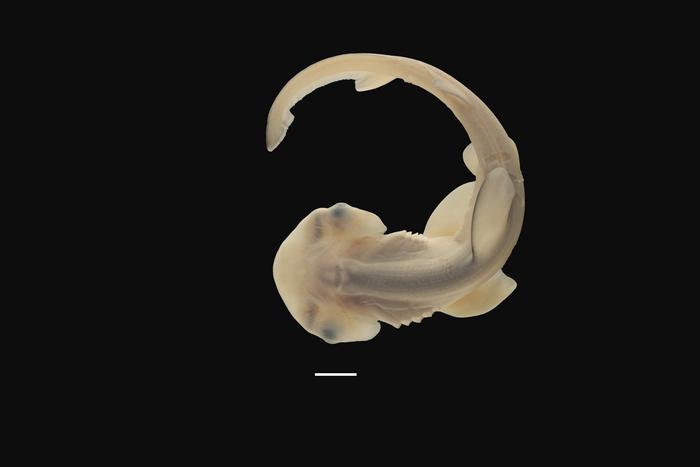For weeks, you’d be hard pressed to tell if the rapidly growing animal was going to become a chicken, a fish, a frog, or even a human.

Credit: Gareth Fraser
For weeks, you’d be hard pressed to tell if the rapidly growing animal was going to become a chicken, a fish, a frog, or even a human.
Then out of nowhere: the hammer.
In an unprecedented look at perhaps the strangest, most captivating animals in the ocean, University of Florida scientists have documented how hammerhead sharks stretch and distort their skulls into their namesake hammer-like shape.
“This is a look at how monsters form,” said Gareth Fraser, a UF professor of biology who supervised the new study. “This is an insight into the development of a wonder of nature that we haven’t seen before and may not be able to see again.”
In a series of striking pictures, the study reveals how, roughly halfway through gestation, two-inch-long bonnethead shark embryos suddenly widen their heads. The growing skull pushes out their still-growing eyes at unnatural-looking angles. In the following weeks, the front of the hammer rounds out as it pushes backward toward the gills, creating the final shovel-like shape.
A couple months later, the fully-formed, foot-long shark is born.
Fraser and his graduate student Steven Byrum led the work to document in careful detail the development of bonnetheads, the smallest hammerhead shark species. Bonnetheads are abundant in the Gulf of Mexico and the Atlantic Ocean and spend time near shore, making them relatively easy to study.
But this detailed look at hammerhead development had previously escaped scientists. Most fish, and many sharks, lay eggs that can be easily collected and examined back at the lab. Hammerheads give birth to live young, which makes it exceedingly difficult to watch embryos develop. Many species are endangered, prohibiting the harvesting of sharks to study their young.
Fraser’s team made the most of existing specimens. Through their collaborators, they gained access to embryos that were preserved from bonnetheads caught during other biological studies. No additional sharks were harmed to complete the study.
Because of the difficulty of studying hammerheads, the scientists say that such a close look at their development may never happen again.
“It’s the perfect qualities of the bonnethead that allowed us do it with this species,” said Byrum. “This was a unique opportunity we may not be able to get for very much longer with bonnetheads and may not be able to get in any other species of hammerhead.”
Byrum and Fraser worked with Gavin Naylor, director of the Florida Program for Shark Research at the Florida Museum of Natural History, and scientists from the South Carolina Department of Natural Resources and Florida State University to publish their findings Sept. 28 in the journal Developmental Dynamics.
The documentation sets up future experiments to determine how hammerheads control their head shape and why they evolved their unusual features, which are thought to amplify their field of vision and ability to detect electrical movements of prey.
Journal
Developmental Dynamics
DOI
10.1002/dvdy.658
Method of Research
Observational study
Subject of Research
Animals
Article Title
Embryonic development in the bonnethead (Sphyrna tiburo), a viviparous hammerhead shark
Article Publication Date
28-Sep-2023




